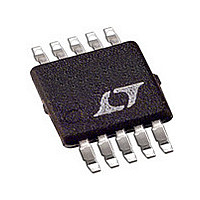LTC4212CMSTR Linear Technology, LTC4212CMSTR Datasheet - Page 15

LTC4212CMSTR
Manufacturer Part Number
LTC4212CMSTR
Description
Manufacturer
Linear Technology
Datasheet
1.LTC4212CMSTR.pdf
(24 pages)
Specifications of LTC4212CMSTR
Linear Misc Type
Positive Low Voltage
Family Name
LTC4212
Package Type
MSOP
Operating Supply Voltage (min)
2.5V
Operating Supply Voltage (max)
16.5V
Operating Temperature (min)
0C
Operating Temperature (max)
70C
Operating Temperature Classification
Commercial
Product Depth (mm)
3mm
Product Height (mm)
0.86mm
Product Length (mm)
3mm
Mounting
Surface Mount
Pin Count
10
Lead Free Status / Rohs Status
Not Compliant
OPERATIO
comparator outputs of a supply monitor such as the
LTC1727 are similar to PGI (PGOOD) and PGF (PGOOD).
First Timing Cycle
When the PC board makes contact with the backplane
(Time Point 1), V
LTC4212 is in UVLO mode. The GATE pin is pulled to
ground by a 200 A current source to shut off the external
N-channel MOSFET and the TIMER, PGT and PGF pins are
all pulled low by internal N-channel FETs M6, M5 and M12.
When V
Point 2), the LTC4212 waits for the ON pin to go high ( >
1.316V) and checks that the GATE is low (V
before initiating the first timing cycle (Time Point 3).
The first timing cycle begins with the TIMER pin up at a rate
given by Equation 1. At Time Point 4 (the timing period
programmed by C
V
to Time Point 5 where V
LTC4212 checks that the FAULT pin voltage is high (V
> 1.236V) before initiating the second timing cycle. If
FAULT is forced low externally, the second timing cycle
will not start and the external N-channel FET stays OFF.
Second Timing Cycle
At the beginning of the second timing cycle (Time Point 6),
the LTC4212 FAST COMP is armed and the soft-start
circuit is enabled. The GATE pin is ramped up at a rate
given by Equation 6. If the inrush current from the backplane
supply (Equation 7) is large enough to cause the voltage
drop across the sense resistor to exceed 50mV, the soft-
start circuit activates to regulate the inrush current (Equa-
tion 5). The soft-start circuit continues to operate until
Time Point 8 when the TIMER pin voltage equals V
1.236V again. At Time Point 8, SLOW COMP is armed and
the power good circuit is enabled.
When the power good circuit is enabled, M12, the internal
N-channel FET shorting the PGT pin to ground is switched
OFF and the power good timer started. The DC/DC convert-
ers enter regulation at Time Point 10. In applications
where the PGI pin is connected to the PGOOD pin of a DC/
DC converter, PGI is pulled high shortly after the converter
enters into regulation (see PGI (PGOOD) waveform). In
TMR
= 1.236V. Next the TIMER pin is pulled down by M6
CC
rises above the UVLO threshold of 2.34V (Time
CC
U
TIMER
starts to rise. While V
), the TIMER pin voltage equals
TMR
= 0.2V. At Time Point 5, the
CC
GATE
< 2.23V, the
< 0.2V)
TMR
FAULT
=
applications where PGI monitors the RST output of a
supply monitor like the LTC1326-2.5, the RST and there-
fore the PGI pins are held low for another 200ms until Time
Point 11 (see PGI (RST) waveform). At Time Point 12, the
power good circuit samples the PGI pin. During normal
power-up, PGI will go high before Time Point 12. The
power good circuit disables and resets the power good
timer and M12 is turned ON to pull PGT to ground. The
power good glitch filter is then enabled to monitor the
PGI pin.
Power Good Glitch Filter Sequence
The power good glitch filter sequence is also shown in
Figure 2 from Time Points 12 through 16. When the glitch
filter is enabled, M5, the internal N-channel FET that shorts
the PGF pin to GND is switched OFF whenever PGI is low.
This allows the C
5 A current source towards 1.236V. If the PGF pin voltage
exceeds 1.236V, the power good circuit trips the circuit
breaker to latch the part off. Tying PGF to GND disables the
glitch filter and prevents the power good from tripping the
circuit breaker after Time Point 12.
For supply monitors such as the LTC1326-2.5, the glitch
filter is less useful. The comparators in the LTC1326-2.5
that monitor the DC/DC converters have a typical propaga-
tion delay of 13 s. If any of the monitored supplies leave
regulation for more than 13 s, the RST signal will be
pulled low until 200ms after all the supplies re-enter
regulation. The net effect is that the LTC1326-2.5 per-
forms the glitch filtering and rejects pulses shorter than
13 s. The PGOOD output of a DC/DC converter does not
have the 200ms delay of the LTC1326-2.5. Thus any low
PGOOD pulse will immediately cause C
towards 1.236V (Time Points 13 and 14). C
be selected to reject low pulses that are shorter than some
desired pulse width.
Some supply monitor ICs such as the LTC1727 provide
access to the outputs of comparators monitoring the DC/DC
converters as well as the RST output. The comparator
outputs track the converter output voltages. If the LTC4212
PGI pin is used to monitor the output of a comparator rather
than the RST output of the LTC1727, C
to reject low pulses shorter than a desired pulse width.
PGF
capacitor to be charged by an internal
PGF
PGF
LTC4212
can be selected
PGF
to be charged
values can
15
4212f













